Autonomous Drone Delivery Market
Autonomous Drone Delivery Market Size and Share Forecast Outlook 2025 to 2035
Autonomous drone delivery market is projected to grow from USD 1.5 billion in 2025 to USD 15.0 billion by 2035, at a CAGR of 25.9%. E-commerce will dominate with a 50.0% market share, while multirotor will lead the drone type segment with a 60.0% share.
Autonomous Drone Delivery Market Forecast and Outlook 2025 to 2035
The global autonomous drone delivery market is valued at USD 1.5 billion in 2025 and is slated to reach USD 15.0 billion by 2035, recording an absolute increase of USD 13.5 billion over the forecast period. This translates into a total growth of 900.0%, with the market forecast to expand at a compound annual growth rate (CAGR) of 25.9% between 2025 and 2035.
The overall market size is expected to grow by approximately 10.0X during the same period, supported by increasing demand for fully automated delivery solutions, growing adoption of artificial intelligence technologies across e-commerce and medical sectors, and rising preference for unmanned logistics optimization in industrial applications.
Quick Stats for Autonomous Drone Delivery Market
- Autonomous Drone Delivery Market Value (2025): USD 1.5 billion
- Autonomous Drone Delivery Market Forecast Value (2035): USD 15.0 billion
- Autonomous Drone Delivery Market Forecast CAGR: 25.9%
- Leading Application in Autonomous Drone Delivery Market: E-commerce (50.0%)
- Key Growth Regions in Autonomous Drone Delivery Market: North America, Europe, Asia Pacific
- Key Players in Autonomous Drone Delivery Market: Wing, Amazon Prime Air, Zipline, DHL, Matternet, Flytrex, Volansi, JD.com, DroneUp, Flirtey
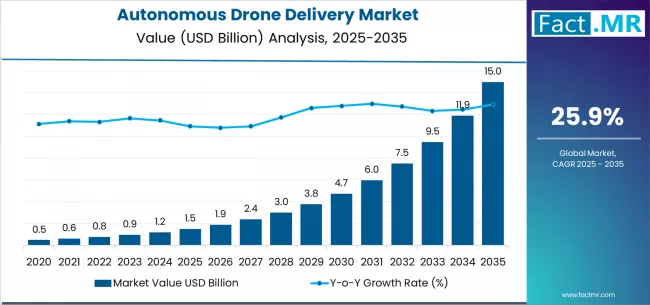
The autonomous drone delivery market represents a specialized segment of the global automation and logistics industry, characterized by technological innovation and robust demand across e-commerce, medical, and industrial channels. Market dynamics are influenced by evolving AI capabilities for autonomous navigation, growing interest in unmanned delivery technologies, and expanding partnerships between drone manufacturers and logistics companies in developed and emerging economies. Traditional human-operated delivery systems continue evolving as operators seek proven autonomous alternatives that offer enhanced automation characteristics and reliable operational benefits.
Consumer behavior in the autonomous drone delivery market reflects broader logistics trends toward fully automated, intelligent systems that provide both operational benefits and extended efficiency improvements. The market benefits from the growing popularity of e-commerce applications, which are recognized for their superior automation capabilities and service compatibility across retail and logistics applications. Additionally, the versatility of autonomous drone delivery as both standalone logistics solutions and integrated automation components supports demand across multiple commercial applications and efficiency segments.
Regional adoption patterns vary significantly, with North American markets showing strong preference for e-commerce implementations, while European markets demonstrate increasing adoption of medical applications alongside conventional industrial systems. The automation landscape continues to evolve with sophisticated and feature-rich autonomous products gaining traction in mainstream operations, reflecting operator willingness to invest in proven AI technology improvements and automation-oriented features.
The competitive environment features established tech companies alongside specialized autonomous drone manufacturers that focus on unique AI capabilities and advanced automation methods. Operational efficiency and technology development optimization remain critical factors for market participants, particularly as regulatory compliance and performance standards continue to evolve. Service strategies increasingly emphasize multi-channel approaches that combine traditional logistics supply chains with direct automation partnerships through technology licensing agreements and custom AI contracts.
Market consolidation trends indicate that larger tech companies are acquiring specialty autonomous drone providers to diversify their automation portfolios and access specialized AI segments. Advanced intelligence integration has gained momentum as e-commerce companies seek to differentiate their offerings while maintaining competitive automation standards. The emergence of specialized autonomous variants, including enhanced AI formulations and application-specific options, reflects changing logistics priorities and creates new market opportunities for innovative automation system developers.
Between 2025 and 2030, the autonomous drone delivery market is projected to expand from USD 1.5 billion to USD 4.6 billion, resulting in a value increase of USD 3.1 billion, which represents 23.0% of the total forecast growth for the decade. This phase of development will be shaped by increasing adoption of AI-powered systems, rising demand for e-commerce automation solutions, and growing emphasis on autonomous navigation features with advanced intelligence characteristics. Service facilities are expanding their AI capabilities to address the growing demand for specialized autonomous implementations, advanced automation options, and application-specific offerings across logistics segments.
Autonomous Drone Delivery Market Key Takeaways
| Metric | Value |
|---|---|
| Estimated Value (2025E) | USD 1.5 billion |
| Forecast Value (2035F) | USD 15.0 billion |
| Forecast CAGR (2025-2035) | 25.9% |
From 2030 to 2035, the market is forecast to grow from USD 4.6 billion to USD 15.0 billion, adding another USD 10.4 billion, which constitutes 77.0% of the overall ten-year expansion. This period is expected to be characterized by the expansion of medical applications, the integration of innovative AI solutions, and the development of specialized autonomous implementations with enhanced intelligence profiles and extended operational capabilities. The growing adoption of advanced AI formulations will drive demand for autonomous drone delivery with superior automation characteristics and compatibility with modern logistics technologies across commercial operations.
Between 2020 and 2025, the autonomous drone delivery market experienced exponential growth, driven by increasing demand for AI-powered systems and growing recognition of full automation as essential components for modern logistics and e-commerce delivery across commercial and retail applications. The market developed as logistics operators recognized the potential for autonomous solutions to provide both efficiency benefits and operational advantages while enabling streamlined automation protocols. Technological advancement in AI processes and application-based development began emphasizing the critical importance of maintaining automation quality and operational compatibility in diverse commercial environments.
Why is the Autonomous Drone Delivery Market Growing?
Market expansion is being supported by the increasing global demand for advanced automated logistics systems and the corresponding need for autonomous technologies that can provide superior AI benefits and operational advantages while enabling enhanced delivery performance and extended compatibility across various e-commerce and medical applications. Modern logistics operators and delivery specialists are increasingly focused on implementing proven AI technologies that can deliver effective full automation, minimize traditional human intervention concerns, and provide consistent performance throughout complex logistics configurations and diverse operational conditions. Autonomous drone delivery proven ability to deliver exceptional automation against traditional alternatives, enable advanced AI integration, and support modern intelligence protocols makes it an essential component for contemporary e-commerce and medical operations.
The growing emphasis on operational automation and logistics intelligence is driving demand for services that can support large-scale commercial requirements, improve delivery outcomes, and enable advanced AI systems. Operator preference for services that combine effective automation with proven reliability and intelligence enhancement benefits is creating opportunities for innovative autonomous implementations. The rising influence of digital transformation trends and AI awareness is also contributing to increased demand for autonomous drone delivery that can provide advanced features, seamless logistics integration, and reliable performance across extended operational cycles.
Opportunity Pathways - Autonomous Drone Delivery Market
The autonomous drone delivery market is poised for exponential growth and technological advancement. As logistics facilities across North America, Europe, Asia-Pacific, and emerging markets seek services that deliver exceptional AI characteristics, advanced automation capabilities, and reliable delivery options, autonomous solutions are gaining prominence not just as logistics services but as strategic enablers of intelligence technologies and advanced automation functionality.
Rising e-commerce adoption in retail applications and expanding medical delivery enhancement initiatives globally amplify demand, while operators are leveraging innovations in AI engineering, advanced automation integration, and intelligence optimization technologies.
- Pathway A - E-commerce Automation Implementations. Premium retail and logistics companies increasingly require delivery solutions with e-commerce bases and advanced AI profiles for enhanced operational appeal and automation positioning capabilities. Technology developers who develop e-commerce platforms with superior intelligence standards can command premium pricing. Expected revenue pool: USD 3.8 billion - USD 5.7 billion.
- Pathway B - Medical Delivery Platforms. Growing demand for medical applications, high-speed capabilities, and unique automation features drives need for advanced medical capabilities with specialized healthcare integration. Opportunity: USD 2.3 billion - USD 3.4 billion.
- Pathway C - Multirotor Technology Applications. Advanced multirotor formulations capable of meeting specific delivery requirements, payload compatibility, and specialized flight profiles enable market expansion and enhanced service appeal for delivery-focused operations. Revenue lift: USD 4.5 billion - USD 6.8 billion.
- Pathway D - Industrial Automation Integration. Expanding reach into industrial applications with optimized automation delivery, advanced AI capabilities, and extended functionality features. Operators will seek partners who supply integrated industrial solutions with complete autonomous functionality. Pool: USD 1.5 billion - USD 2.3 billion.
- Pathway E - Geographic Expansion & Local AI Operations. Strong growth in APAC, particularly China, India, and Southeast Asia. Local AI operations lower costs, reduce technology complexity, and enable faster response to regional automation preferences. Expected upside: USD 2.3 billion - USD 3.4 billion.
- Pathway F - Fixed-wing Development. Increasing demand for fixed-wing autonomous systems, application-specific functionality, and specialized delivery profiles with validated performance characteristics for logistics facilities. USD 1.9 billion - USD 2.8 billion.
- Pathway G - Hybrid Technology Expansion. Developing comprehensive hybrid autonomous solutions, custom AI services, and enhancement programs creates differentiation and addresses specialized requirements for complex delivery applications and facility operators. Growing demand from independent logistics services. Pool: USD 1.1 billion - USD 1.7 billion.
Segmental Analysis
The market is segmented by application, drone type, and region. By application, the market is divided into e-commerce, medical, and industrial categories. By drone type, it covers multirotor, fixed-wing, and hybrid segments. Regionally, the market is divided into North America, Europe, and Asia-Pacific.
How is E-commerce influencing Demand for Autonomous Drone Delivery Services?
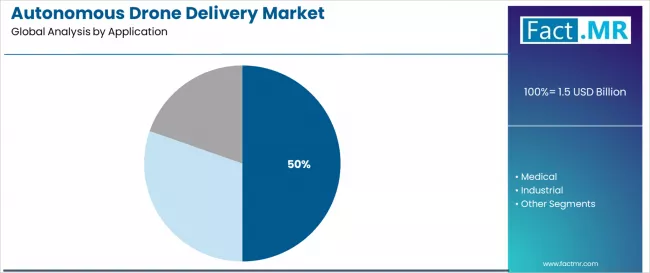
The e-commerce segment is projected to account for 50.0% of the autonomous drone delivery market in 2025, reaffirming its position as the leading application category. Logistics facilities and delivery integrators increasingly utilize e-commerce implementations for their superior automation characteristics when operating across diverse delivery platforms, excellent AI properties, and widespread acceptance in applications ranging from basic package delivery to premium retail operations. E-commerce delivery technology's established AI methods and proven automation capabilities directly address the facility requirements for dependable delivery solutions in complex logistics environments.
This application segment forms the foundation of modern retail adoption patterns, as it represents the implementation with the greatest market penetration and established operator acceptance across multiple delivery categories and automation segments. Facility investments in e-commerce standardization and system consistency continue to strengthen adoption among retail producers and logistics companies. With operators prioritizing delivery automation and operational efficiency, e-commerce implementations align with both functionality preferences and cost expectations, making them the central component of comprehensive logistics automation strategies.
Why do Multirotor Autonomous Drones Preferred for Delivery Operations?
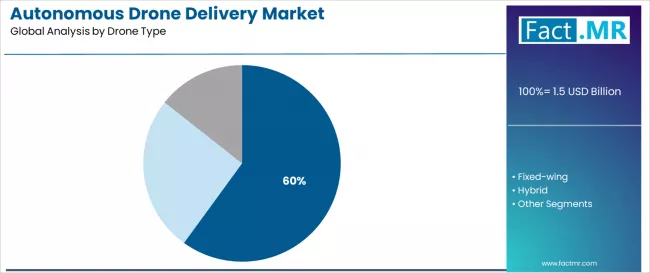
Multirotor applications are projected to represent 60.0% of autonomous drone delivery demand in 2025, underscoring their critical role as the primary drone type for automation enhancement across urban and suburban operations. Logistics facilities prefer multirotors for autonomous delivery for their exceptional maneuverability characteristics, scalable flight options, and ability to enhance delivery precision while ensuring consistent operational quality throughout diverse logistics platforms and delivery operations. Positioned as essential flight components for modern autonomous systems, multirotor solutions offer both technological advantages and operational efficiency benefits.
The segment is supported by continuous innovation in AI technologies and the growing availability of specialized implementations that enable diverse delivery requirements with enhanced precision uniformity and extended flight capabilities. Additionally, logistics facilities are investing in advanced technologies to support large-scale automation integration and service development. As urban delivery trends become more prevalent and AI awareness increases, multirotor applications will continue to represent a major implementation market while supporting advanced logistics utilization and technology integration strategies.
How will Autonomous Drone Delivery play a Role in the Medical Segment?
The medical segment is expected to capture 30.0% of the autonomous drone delivery market in 2025, driven by increasing demand for healthcare automation systems that enhance patient care while maintaining operational efficiency.
Healthcare providers are increasingly adopting autonomous drone delivery for medical supply transport, pharmaceutical delivery, and emergency response due to their superior speed and reliability characteristics. The segment benefits from growing telemedicine requirements and continuous innovation in automation formulations tailored for healthcare applications.
What are the Drivers, Restraints, and Key Trends of the Autonomous Drone Delivery Market?
The autonomous drone delivery market is advancing exponentially due to increasing demand for advanced AI-powered delivery technologies and growing adoption of autonomous systems that provide superior automation characteristics and operational benefits while enabling enhanced logistics performance across diverse e-commerce and medical applications. The market faces challenges, including complex AI requirements, evolving regulatory standards, and the need for specialized automation expertise and safety programs. Innovation in AI methods and advanced autonomous systems continues to influence service development and market expansion patterns.
Expansion of AI Technologies and Logistics Automation
The growing adoption of advanced AI solutions, sophisticated automation capabilities, and logistics intelligence awareness is enabling service developers to produce advanced autonomous solutions with superior AI positioning, enhanced automation profiles, and seamless integration functionalities.
Advanced AI systems provide improved logistics outcomes while allowing more efficient operational workflows and reliable performance across various commercial applications and delivery conditions. Developers are increasingly recognizing the competitive advantages of logistics automation capabilities for market differentiation and service positioning.
Integration of Advanced AI Methods and Automation Engineering
Modern autonomous drone delivery providers are incorporating advanced AI technology, automation integration, and sophisticated operational solutions to enhance service appeal, enable intelligent delivery features, and deliver value-added solutions to logistics customers.
These technologies improve autonomous performance while enabling new market opportunities, including multi-stage AI systems, optimized automation treatments, and enhanced intelligence characteristics. Advanced AI integration also allows developers to support comprehensive logistics technologies and market expansion beyond traditional delivery approaches.
What are the Growth Prospects for Autonomous Drone Delivery across Key Countries?
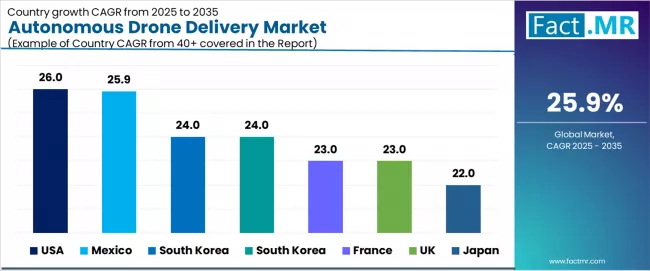
| Country | CAGR (2025-2035) |
|---|---|
| USA | 26.0% |
| Mexico | 25.9% |
| South Korea | 24.0% |
| Germany | 24.0% |
| UK | 23.0% |
| France | 23.0% |
| Japan | 22.0% |
The autonomous drone delivery industry is experiencing explosive growth globally, with the USA leading at a 26.0% CAGR through 2035, driven by expanding e-commerce capacity, growing AI automation programs, and significant investment in autonomous technology development. Mexico follows at 25.9%, supported by increasing logistics expansion, growing automation integration patterns, and expanding AI infrastructure. South Korea shows growth at 24.0%, emphasizing AI technology leadership and automation development.
Germany records 24.0%, focusing on expanding logistics capabilities and AI technology modernization. The UK exhibits 23.0% growth, emphasizing automation innovation excellence and premium AI development. France demonstrates 23.0% growth, prioritizing advanced logistics technology development and quality-focused automation patterns. Japan shows 22.0% growth, supported by AI initiatives and quality-focused autonomous patterns.
How is E-commerce Automation influencing Autonomous Drone Delivery in USA?
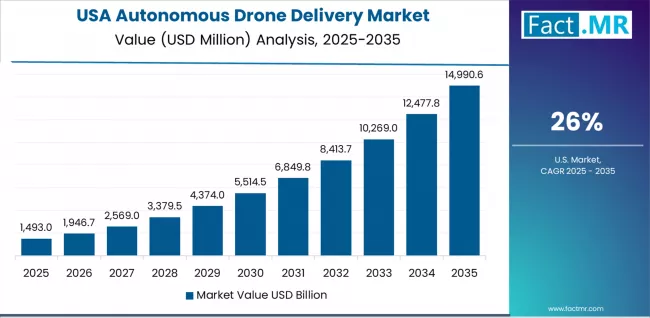
Revenue from autonomous drone delivery in the USA is projected to exhibit exceptional growth with a CAGR of 26.0% through 2035, driven by expanding e-commerce capacity and rapidly growing AI logistics integration supported by government initiatives promoting autonomous technology development. The country's strong position in e-commerce and increasing investment in AI infrastructure are creating substantial demand for advanced autonomous implementations. Major logistics facilities and technology companies are establishing comprehensive AI capabilities to serve both domestic e-commerce demand and expanding medical markets.
Government support for autonomous aviation initiatives and AI delivery development is driving demand for advanced autonomous systems throughout major logistics regions and distribution centers across the country. Strong e-commerce growth and an expanding network of technology-focused operators are supporting the rapid adoption of autonomous drone delivery among companies seeking advanced AI capabilities and integrated automation technologies.
Will AI Incorporation in the Logistics Sector Strengthen Autonomous Drone Delivery Prospects in Mexico?
Revenue from autonomous drone delivery in Mexico is growing at a CAGR of 25.9%, driven by the country's expanding logistics sector, growing AI capacity, and increasing adoption of autonomous delivery technologies. The country's initiatives promoting logistics modernization and growing automation development awareness are driving requirements for technology-integrated AI systems. International autonomous providers and domestic logistics companies are establishing extensive AI and integration capabilities to address the growing demand for advanced autonomous solutions.
Strong logistics expansion and expanding modern automation operations are driving adoption of integrated AI systems with superior autonomous capabilities and advanced integration among large logistics producers and progressive delivery operations. Growing technology diversity and increasing logistics enhancement adoption are supporting market expansion for advanced autonomous implementations with seamless integration profiles and modern AI delivery throughout the country's logistics regions. Mexico's strategic location and expanding e-commerce market make it an attractive destination for autonomous service facilities serving both domestic and North American markets.
How will South Korea Influence Expansion of the Autonomous Drone Delivery Landscape?
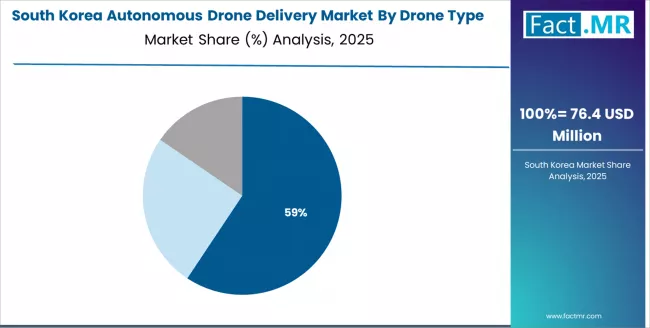
Revenue from autonomous drone delivery in South Korea is growing at a CAGR of 24.0%, driven by the country's expanding technology sector, growing AI integration capacity, and increasing adoption of autonomous logistics technologies. The country's initiatives promoting technology modernization and growing automation development awareness are driving requirements for technology-integrated AI systems. International autonomous providers and domestic technology companies are establishing extensive AI and integration capabilities to address the growing demand for advanced autonomous solutions.
Rising technology requirements and expanding automation programs are creating opportunities for autonomous adoption across technology centers, progressive producers, and modern logistics facilities in major technology regions. Growing focus on AI integration and automation improvement features is driving adoption of autonomous platforms among operators seeking enhanced AI capabilities and advanced automation experiences.
How does Innovation in Delivery Technology influence Germany’s Autonomous Drone Delivery Ecosystem?
Revenue from autonomous drone delivery in Germany is expanding at a CAGR of 24.0%, supported by the country's AI technology heritage, strong emphasis on automation technology, and robust demand for advanced autonomous systems in e-commerce and medical applications. The nation's mature technology sector and AI-focused operations are driving sophisticated autonomous implementations throughout the industry. Leading facilities and technology specialists are investing extensively in AI development and advanced integration technologies to serve both domestic and international markets.
Rising demand for automation technologies and advanced AI systems is creating requirements for sophisticated autonomous solutions with exceptional intelligence capabilities among quality-conscious facilities seeking enhanced automation experiences and advanced integration methods. Strong technology tradition and growing investment in AI technologies are supporting adoption of quality autonomous platforms with advanced development methods and enhanced automation profiles across logistics operations in major technology regions.
What is the Outlook for the Autonomous Drone Delivery Market in the UK?
Revenue from autonomous drone delivery in the UK is growing at a CAGR of 23.0%, driven by the country's focus on AI technology advancement, emphasis on premium automation innovation, and strong position in autonomous delivery development. The UK's established technology innovation capabilities and commitment to technology diversification are supporting investment in specialized autonomous technologies throughout major logistics regions. Industry leaders are establishing comprehensive technology integration systems to serve domestic premium logistics production and automation applications.
Innovations in AI platforms and automation integration capabilities are creating demand for advanced autonomous implementations with exceptional intelligence properties among progressive logistics facilities seeking enhanced technology differentiation and automation appeal. Growing premium logistics adoption and increasing focus on AI innovation are driving adoption of advanced autonomous platforms with integrated AI delivery and automation optimization across logistics enterprises throughout the country.
Will France Provide Opportunities for Expansion of the Autonomous Drone Delivery Landscape?
The autonomous drone delivery ecosystem in France is growing at a CAGR of 23.0%, driven by the country's expanding logistics sector, growing automation development programs, and increasing investment in AI technology development. France's large e-commerce market and commitment to logistics advancement are supporting demand for diverse autonomous solutions across multiple delivery segments. Technology providers are establishing comprehensive integration capabilities to serve the growing domestic market and expanding logistics opportunities.
Strong logistics expansion and expanding modern automation operations are driving adoption of integrated AI systems with superior autonomous capabilities and advanced integration among large logistics producers and progressive delivery operations. Growing technology diversity and increasing logistics enhancement adoption are supporting market expansion for advanced autonomous implementations with seamless integration profiles and modern AI delivery throughout the country's logistics regions.
Why is Japan Emerging as a High-Growth Potential Region for Autonomous Drone Delivery?
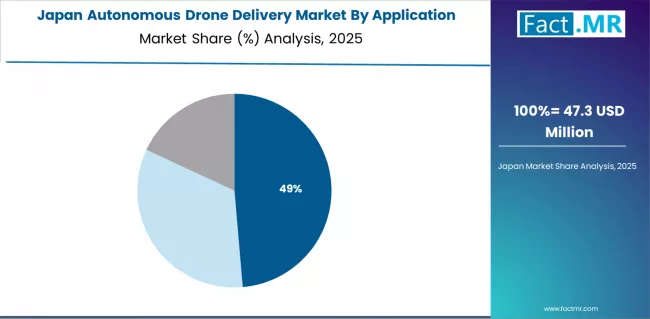
Revenue from autonomous drone delivery in Japan is expanding at a CAGR of 22.0%, supported by the country's AI excellence initiatives, growing quality technology sector, and strategic emphasis on advanced automation development. Japan's advanced quality control capabilities and integrated AI systems are driving demand for high-quality autonomous platforms in premium applications, logistics technology, and advanced automation applications. Leading facilities are investing in specialized capabilities to serve the stringent requirements of technology-focused logistics and premium e-commerce producers.
Quality AI advancement and technology-focused development are creating requirements for specialized autonomous solutions with superior quality integration, exceptional AI capabilities, and advanced automation features among quality-conscious logistics operations and premium e-commerce producers. Strong position in AI technology innovation is supporting adoption of advanced autonomous systems with validated automation characteristics and quality integration capabilities throughout the country's logistics technology sector.
How are Growth Patterns in the Autonomous Drone Delivery Sector unfolding across Europe?
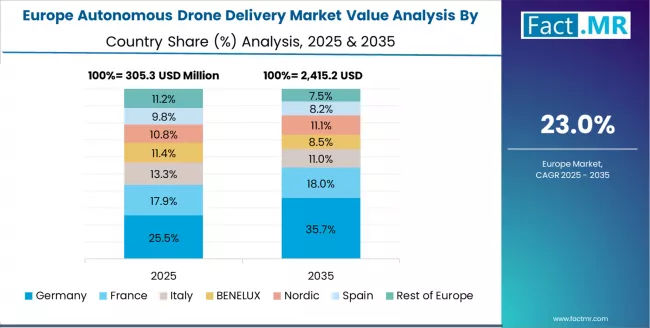
The autonomous drone delivery market in Europe is projected to grow from USD 0.5 billion in 2025 to USD 4.5 billion by 2035, registering a CAGR of 23.8% over the forecast period. Germany is expected to maintain its leadership position with a 28.0% market share in 2025, growing to 29.2% by 2035, supported by its strong AI technology culture, sophisticated logistics capabilities, and comprehensive automation sector serving diverse autonomous applications across Europe.
France follows with a 25.9% share in 2025, projected to reach 24.8% by 2035, driven by robust demand for logistics technologies in automation applications, advanced AI development programs, and intelligence markets, combined with established e-commerce infrastructure and technology integration expertise. The UK holds a 22.0% share in 2025, expected to reach 21.5% by 2035, supported by strong AI technology sector and growing premium logistics activities.
Italy commands a 15.0% share in 2025, projected to reach 14.2% by 2035, while Netherlands accounts for 7.0% in 2025, expected to reach 7.3% by 2035. The Rest of Europe region is anticipated to maintain momentum, with its collective share moving from 3.0% to 3.0% by 2035, attributed to increasing logistics modernization and growing technology penetration implementing advanced autonomous programs.
Competitive Landscape of the Autonomous Drone Delivery Market
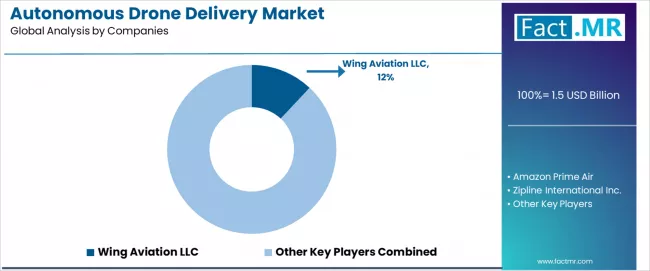
The autonomous drone delivery market is characterized by intense competition among established tech companies, specialized AI drone manufacturers, and integrated automation solution providers. Companies are investing in AI technology research, automation optimization, advanced operational system development, and comprehensive autonomous portfolios to deliver consistent, high-quality, and application-specific autonomous drone solutions. Innovation in advanced AI integration, automation enhancement, and logistics compatibility improvement is central to strengthening market position and competitive advantage.
Wing Aviation LLC leads the market with a 12% market share, offering comprehensive autonomous solutions including quality AI platforms and advanced automation systems with a focus on premium and e-commerce applications. Amazon Prime Air provides specialized delivery capabilities with an emphasis on advanced autonomous implementations and innovative logistics solutions.
Zipline delivers comprehensive medical services with a focus on integrated platforms and large-scale healthcare applications. DHL specializes in advanced logistics technologies and specialized autonomous implementations for premium applications. Matternet focuses on medical-oriented delivery integration and innovative AI solutions.
The competitive landscape is further strengthened by companies like Flytrex, which brings expertise in advanced urban autonomous delivery, while Volansi focuses on long-range autonomous solutions for diverse applications. JD.com emphasizes e-commerce automation systems and operational integration, and DroneUp specializes in retail autonomous formulations. These companies continue to invest in research and development, strategic partnerships, and operational capacity expansion to maintain their market positions and capture emerging opportunities in the rapidly growing autonomous drone delivery sector.
Key Players in the Autonomous Drone Delivery Market
- Wing Aviation LLC
- Amazon Prime Air
- Zipline International Inc.
- DHL Express (Deutsche Post AG)
- Matternet Inc.
- Flytrex Aviation Ltd.
- Volansi Inc.
- JD.com, Inc.
- DroneUp LLC
- Flirtey Holdings Inc.
- Skycart Inc.
Scope of the Report
| Item | Value |
|---|---|
| Quantitative Units | USD 1.5 Billion |
| Application | E-commerce; Medical; Industrial |
| Drone Type | Multirotor; Fixed-wing; Hybrid |
| Regions Covered | North America; Europe; Asia-Pacific |
| Countries Covered | USA; Mexico; South Korea; Germany; UK; France; Japan; and 40+ additional countries |
| Key Companies Profiled | Wing; Amazon Prime Air; Zipline; DHL; Matternet; Flytrex |
| Additional Attributes | Dollar sales by application and drone type category; regional demand trends; competitive landscape; technological advancements in AI engineering; advanced automation development; intelligence innovation; logistics integration protocols |
Autonomous Drone Delivery Market by Segments
-
Application :
- E-commerce
- Medical
- Industrial
-
Drone Type :
- Multirotor
- Fixed-wing
- Hybrid
-
Region :
- North America
- United States
- Canada
- Mexico
- Europe
- Germany
- UK
- France
- Italy
- Spain
- Nordic
- BENELUX
- Rest of Europe
- Asia-Pacific
- China
- Japan
- South Korea
- India
- ASEAN
- Australia & New Zealand
- Rest of Asia-Pacific
- North America
Table of Content
- Executive Summary
- Global Market Outlook
- Demand to side Trends
- Supply to side Trends
- Technology Roadmap Analysis
- Analysis and Recommendations
- Market Overview
- Market Coverage / Taxonomy
- Market Definition / Scope / Limitations
- Market Background
- Market Dynamics
- Drivers
- Restraints
- Opportunity
- Trends
- Scenario Forecast
- Demand in Optimistic Scenario
- Demand in Likely Scenario
- Demand in Conservative Scenario
- Opportunity Map Analysis
- Product Life Cycle Analysis
- Supply Chain Analysis
- Investment Feasibility Matrix
- Value Chain Analysis
- PESTLE and Porter’s Analysis
- Regulatory Landscape
- Regional Parent Market Outlook
- Production and Consumption Statistics
- Import and Export Statistics
- Market Dynamics
- Global Market Analysis 2020 to 2024 and Forecast, 2025 to 2035
- Historical Market Size Value (USD Million) Analysis, 2020 to 2024
- Current and Future Market Size Value (USD Million) Projections, 2025 to 2035
- Y to o to Y Growth Trend Analysis
- Absolute $ Opportunity Analysis
- Global Market Pricing Analysis 2020 to 2024 and Forecast 2025 to 2035
- Global Market Analysis 2020 to 2024 and Forecast 2025 to 2035, By Application
- Introduction / Key Findings
- Historical Market Size Value (USD Million) Analysis By Application , 2020 to 2024
- Current and Future Market Size Value (USD Million) Analysis and Forecast By Application , 2025 to 2035
- E-commerce
- Medical
- Industrial
- Y to o to Y Growth Trend Analysis By Application , 2020 to 2024
- Absolute $ Opportunity Analysis By Application , 2025 to 2035
- Global Market Analysis 2020 to 2024 and Forecast 2025 to 2035, By Drone Type
- Introduction / Key Findings
- Historical Market Size Value (USD Million) Analysis By Drone Type, 2020 to 2024
- Current and Future Market Size Value (USD Million) Analysis and Forecast By Drone Type, 2025 to 2035
- Multirotor
- Fixed-wing
- Hybrid
- Y to o to Y Growth Trend Analysis By Drone Type, 2020 to 2024
- Absolute $ Opportunity Analysis By Drone Type, 2025 to 2035
- Global Market Analysis 2020 to 2024 and Forecast 2025 to 2035, By Region
- Introduction
- Historical Market Size Value (USD Million) Analysis By Region, 2020 to 2024
- Current Market Size Value (USD Million) Analysis and Forecast By Region, 2025 to 2035
- North America
- Latin America
- Western Europe
- Eastern Europe
- East Asia
- South Asia and Pacific
- Middle East & Africa
- Market Attractiveness Analysis By Region
- North America Market Analysis 2020 to 2024 and Forecast 2025 to 2035, By Country
- Historical Market Size Value (USD Million) Trend Analysis By Market Taxonomy, 2020 to 2024
- Market Size Value (USD Million) Forecast By Market Taxonomy, 2025 to 2035
- By Country
- USA
- Canada
- Mexico
- By Application
- By Drone Type
- By Country
- Market Attractiveness Analysis
- By Country
- By Application
- By Drone Type
- Key Takeaways
- Latin America Market Analysis 2020 to 2024 and Forecast 2025 to 2035, By Country
- Historical Market Size Value (USD Million) Trend Analysis By Market Taxonomy, 2020 to 2024
- Market Size Value (USD Million) Forecast By Market Taxonomy, 2025 to 2035
- By Country
- Brazil
- Chile
- Rest of Latin America
- By Application
- By Drone Type
- By Country
- Market Attractiveness Analysis
- By Country
- By Application
- By Drone Type
- Key Takeaways
- Western Europe Market Analysis 2020 to 2024 and Forecast 2025 to 2035, By Country
- Historical Market Size Value (USD Million) Trend Analysis By Market Taxonomy, 2020 to 2024
- Market Size Value (USD Million) Forecast By Market Taxonomy, 2025 to 2035
- By Country
- Germany
- UK
- Italy
- Spain
- France
- Nordic
- BENELUX
- Rest of Western Europe
- By Application
- By Drone Type
- By Country
- Market Attractiveness Analysis
- By Country
- By Application
- By Drone Type
- Key Takeaways
- Eastern Europe Market Analysis 2020 to 2024 and Forecast 2025 to 2035, By Country
- Historical Market Size Value (USD Million) Trend Analysis By Market Taxonomy, 2020 to 2024
- Market Size Value (USD Million) Forecast By Market Taxonomy, 2025 to 2035
- By Country
- Russia
- Poland
- Hungary
- Balkan & Baltic
- Rest of Eastern Europe
- By Application
- By Drone Type
- By Country
- Market Attractiveness Analysis
- By Country
- By Application
- By Drone Type
- Key Takeaways
- East Asia Market Analysis 2020 to 2024 and Forecast 2025 to 2035, By Country
- Historical Market Size Value (USD Million) Trend Analysis By Market Taxonomy, 2020 to 2024
- Market Size Value (USD Million) Forecast By Market Taxonomy, 2025 to 2035
- By Country
- China
- Japan
- South Korea
- By Application
- By Drone Type
- By Country
- Market Attractiveness Analysis
- By Country
- By Application
- By Drone Type
- Key Takeaways
- South Asia and Pacific Market Analysis 2020 to 2024 and Forecast 2025 to 2035, By Country
- Historical Market Size Value (USD Million) Trend Analysis By Market Taxonomy, 2020 to 2024
- Market Size Value (USD Million) Forecast By Market Taxonomy, 2025 to 2035
- By Country
- India
- ASEAN
- Australia & New Zealand
- Rest of South Asia and Pacific
- By Application
- By Drone Type
- By Country
- Market Attractiveness Analysis
- By Country
- By Application
- By Drone Type
- Key Takeaways
- Middle East & Africa Market Analysis 2020 to 2024 and Forecast 2025 to 2035, By Country
- Historical Market Size Value (USD Million) Trend Analysis By Market Taxonomy, 2020 to 2024
- Market Size Value (USD Million) Forecast By Market Taxonomy, 2025 to 2035
- By Country
- Kingdom of Saudi Arabia
- Other GCC Countries
- Turkiye
- South Africa
- Other African Union
- Rest of Middle East & Africa
- By Application
- By Drone Type
- By Country
- Market Attractiveness Analysis
- By Country
- By Application
- By Drone Type
- Key Takeaways
- Key Countries Market Analysis
- USA
- Pricing Analysis
- Market Share Analysis, 2024
- By Application
- By Drone Type
- Canada
- Pricing Analysis
- Market Share Analysis, 2024
- By Application
- By Drone Type
- Mexico
- Pricing Analysis
- Market Share Analysis, 2024
- By Application
- By Drone Type
- Brazil
- Pricing Analysis
- Market Share Analysis, 2024
- By Application
- By Drone Type
- Chile
- Pricing Analysis
- Market Share Analysis, 2024
- By Application
- By Drone Type
- Germany
- Pricing Analysis
- Market Share Analysis, 2024
- By Application
- By Drone Type
- UK
- Pricing Analysis
- Market Share Analysis, 2024
- By Application
- By Drone Type
- Italy
- Pricing Analysis
- Market Share Analysis, 2024
- By Application
- By Drone Type
- Spain
- Pricing Analysis
- Market Share Analysis, 2024
- By Application
- By Drone Type
- France
- Pricing Analysis
- Market Share Analysis, 2024
- By Application
- By Drone Type
- India
- Pricing Analysis
- Market Share Analysis, 2024
- By Application
- By Drone Type
- ASEAN
- Pricing Analysis
- Market Share Analysis, 2024
- By Application
- By Drone Type
- Australia & New Zealand
- Pricing Analysis
- Market Share Analysis, 2024
- By Application
- By Drone Type
- China
- Pricing Analysis
- Market Share Analysis, 2024
- By Application
- By Drone Type
- Japan
- Pricing Analysis
- Market Share Analysis, 2024
- By Application
- By Drone Type
- South Korea
- Pricing Analysis
- Market Share Analysis, 2024
- By Application
- By Drone Type
- Russia
- Pricing Analysis
- Market Share Analysis, 2024
- By Application
- By Drone Type
- Poland
- Pricing Analysis
- Market Share Analysis, 2024
- By Application
- By Drone Type
- Hungary
- Pricing Analysis
- Market Share Analysis, 2024
- By Application
- By Drone Type
- Kingdom of Saudi Arabia
- Pricing Analysis
- Market Share Analysis, 2024
- By Application
- By Drone Type
- Turkiye
- Pricing Analysis
- Market Share Analysis, 2024
- By Application
- By Drone Type
- South Africa
- Pricing Analysis
- Market Share Analysis, 2024
- By Application
- By Drone Type
- USA
- Market Structure Analysis
- Competition Dashboard
- Competition Benchmarking
- Market Share Analysis of Top Players
- By Regional
- By Application
- By Drone Type
- Competition Analysis
- Competition Deep Dive
- Wing Aviation LLC
- Overview
- Product Portfolio
- Profitability by Market Segments (Product/Age /Sales Channel/Region)
- Sales Footprint
- Strategy Overview
- Marketing Strategy
- Product Strategy
- Channel Strategy
- Amazon Prime Air
- Zipline International Inc.
- DHL Express (Deutsche Post AG)
- Matternet Inc.
- Flytrex Aviation Ltd.
- Volansi Inc.
- JD.com, Inc.
- DroneUp LLC
- Flirtey Holdings Inc.
- Skycart Inc.
- Wing Aviation LLC
- Competition Deep Dive
- Assumptions & Acronyms Used
- Research Methodology
List Of Table
- Table 1: Global Market Value (USD Million) Forecast by Region, 2020 to 2035
- Table 2: Global Market Value (USD Million) Forecast by Application , 2020 to 2035
- Table 3: Global Market Value (USD Million) Forecast by Drone Type, 2020 to 2035
- Table 4: North America Market Value (USD Million) Forecast by Country, 2020 to 2035
- Table 5: North America Market Value (USD Million) Forecast by Application , 2020 to 2035
- Table 6: North America Market Value (USD Million) Forecast by Drone Type, 2020 to 2035
- Table 7: Latin America Market Value (USD Million) Forecast by Country, 2020 to 2035
- Table 8: Latin America Market Value (USD Million) Forecast by Application , 2020 to 2035
- Table 9: Latin America Market Value (USD Million) Forecast by Drone Type, 2020 to 2035
- Table 10: Western Europe Market Value (USD Million) Forecast by Country, 2020 to 2035
- Table 11: Western Europe Market Value (USD Million) Forecast by Application , 2020 to 2035
- Table 12: Western Europe Market Value (USD Million) Forecast by Drone Type, 2020 to 2035
- Table 13: Eastern Europe Market Value (USD Million) Forecast by Country, 2020 to 2035
- Table 14: Eastern Europe Market Value (USD Million) Forecast by Application , 2020 to 2035
- Table 15: Eastern Europe Market Value (USD Million) Forecast by Drone Type, 2020 to 2035
- Table 16: East Asia Market Value (USD Million) Forecast by Country, 2020 to 2035
- Table 17: East Asia Market Value (USD Million) Forecast by Application , 2020 to 2035
- Table 18: East Asia Market Value (USD Million) Forecast by Drone Type, 2020 to 2035
- Table 19: South Asia and Pacific Market Value (USD Million) Forecast by Country, 2020 to 2035
- Table 20: South Asia and Pacific Market Value (USD Million) Forecast by Application , 2020 to 2035
- Table 21: South Asia and Pacific Market Value (USD Million) Forecast by Drone Type, 2020 to 2035
- Table 22: Middle East & Africa Market Value (USD Million) Forecast by Country, 2020 to 2035
- Table 23: Middle East & Africa Market Value (USD Million) Forecast by Application , 2020 to 2035
- Table 24: Middle East & Africa Market Value (USD Million) Forecast by Drone Type, 2020 to 2035
List Of Figures
- Figure 1: Global Market Pricing Analysis
- Figure 2: Global Market Value (USD Million) Forecast 2020-2035
- Figure 3: Global Market Value Share and BPS Analysis by Application, 2025 and 2035
- Figure 4: Global Market Y to o to Y Growth Comparison by Application, 2025-2035
- Figure 5: Global Market Attractiveness Analysis by Application
- Figure 6: Global Market Value Share and BPS Analysis by Drone Type, 2025 and 2035
- Figure 7: Global Market Y to o to Y Growth Comparison by Drone Type, 2025-2035
- Figure 8: Global Market Attractiveness Analysis by Drone Type
- Figure 9: Global Market Value (USD Million) Share and BPS Analysis by Region, 2025 and 2035
- Figure 10: Global Market Y to o to Y Growth Comparison by Region, 2025-2035
- Figure 11: Global Market Attractiveness Analysis by Region
- Figure 12: North America Market Incremental Dollar Opportunity, 2025-2035
- Figure 13: Latin America Market Incremental Dollar Opportunity, 2025-2035
- Figure 14: Western Europe Market Incremental Dollar Opportunity, 2025-2035
- Figure 15: Eastern Europe Market Incremental Dollar Opportunity, 2025-2035
- Figure 16: East Asia Market Incremental Dollar Opportunity, 2025-2035
- Figure 17: South Asia and Pacific Market Incremental Dollar Opportunity, 2025-2035
- Figure 18: Middle East & Africa Market Incremental Dollar Opportunity, 2025-2035
- Figure 19: North America Market Value Share and BPS Analysis by Country, 2025 and 2035
- Figure 20: North America Market Value Share and BPS Analysis by Application , 2025 and 2035
- Figure 21: North America Market Y to o to Y Growth Comparison by Application , 2025-2035
- Figure 22: North America Market Attractiveness Analysis by Application
- Figure 23: North America Market Value Share and BPS Analysis by Drone Type, 2025 and 2035
- Figure 24: North America Market Y to o to Y Growth Comparison by Drone Type, 2025-2035
- Figure 25: North America Market Attractiveness Analysis by Drone Type
- Figure 26: Latin America Market Value Share and BPS Analysis by Country, 2025 and 2035
- Figure 27: Latin America Market Value Share and BPS Analysis by Application , 2025 and 2035
- Figure 28: Latin America Market Y to o to Y Growth Comparison by Application , 2025-2035
- Figure 29: Latin America Market Attractiveness Analysis by Application
- Figure 30: Latin America Market Value Share and BPS Analysis by Drone Type, 2025 and 2035
- Figure 31: Latin America Market Y to o to Y Growth Comparison by Drone Type, 2025-2035
- Figure 32: Latin America Market Attractiveness Analysis by Drone Type
- Figure 33: Western Europe Market Value Share and BPS Analysis by Country, 2025 and 2035
- Figure 34: Western Europe Market Value Share and BPS Analysis by Application , 2025 and 2035
- Figure 35: Western Europe Market Y to o to Y Growth Comparison by Application , 2025-2035
- Figure 36: Western Europe Market Attractiveness Analysis by Application
- Figure 37: Western Europe Market Value Share and BPS Analysis by Drone Type, 2025 and 2035
- Figure 38: Western Europe Market Y to o to Y Growth Comparison by Drone Type, 2025-2035
- Figure 39: Western Europe Market Attractiveness Analysis by Drone Type
- Figure 40: Eastern Europe Market Value Share and BPS Analysis by Country, 2025 and 2035
- Figure 41: Eastern Europe Market Value Share and BPS Analysis by Application , 2025 and 2035
- Figure 42: Eastern Europe Market Y to o to Y Growth Comparison by Application , 2025-2035
- Figure 43: Eastern Europe Market Attractiveness Analysis by Application
- Figure 44: Eastern Europe Market Value Share and BPS Analysis by Drone Type, 2025 and 2035
- Figure 45: Eastern Europe Market Y to o to Y Growth Comparison by Drone Type, 2025-2035
- Figure 46: Eastern Europe Market Attractiveness Analysis by Drone Type
- Figure 47: East Asia Market Value Share and BPS Analysis by Country, 2025 and 2035
- Figure 48: East Asia Market Value Share and BPS Analysis by Application , 2025 and 2035
- Figure 49: East Asia Market Y to o to Y Growth Comparison by Application , 2025-2035
- Figure 50: East Asia Market Attractiveness Analysis by Application
- Figure 51: East Asia Market Value Share and BPS Analysis by Drone Type, 2025 and 2035
- Figure 52: East Asia Market Y to o to Y Growth Comparison by Drone Type, 2025-2035
- Figure 53: East Asia Market Attractiveness Analysis by Drone Type
- Figure 54: South Asia and Pacific Market Value Share and BPS Analysis by Country, 2025 and 2035
- Figure 55: South Asia and Pacific Market Value Share and BPS Analysis by Application , 2025 and 2035
- Figure 56: South Asia and Pacific Market Y to o to Y Growth Comparison by Application , 2025-2035
- Figure 57: South Asia and Pacific Market Attractiveness Analysis by Application
- Figure 58: South Asia and Pacific Market Value Share and BPS Analysis by Drone Type, 2025 and 2035
- Figure 59: South Asia and Pacific Market Y to o to Y Growth Comparison by Drone Type, 2025-2035
- Figure 60: South Asia and Pacific Market Attractiveness Analysis by Drone Type
- Figure 61: Middle East & Africa Market Value Share and BPS Analysis by Country, 2025 and 2035
- Figure 62: Middle East & Africa Market Value Share and BPS Analysis by Application , 2025 and 2035
- Figure 63: Middle East & Africa Market Y to o to Y Growth Comparison by Application , 2025-2035
- Figure 64: Middle East & Africa Market Attractiveness Analysis by Application
- Figure 65: Middle East & Africa Market Value Share and BPS Analysis by Drone Type, 2025 and 2035
- Figure 66: Middle East & Africa Market Y to o to Y Growth Comparison by Drone Type, 2025-2035
- Figure 67: Middle East & Africa Market Attractiveness Analysis by Drone Type
- Figure 68: Global Market - Tier Structure Analysis
- Figure 69: Global Market - Company Share Analysis
- FAQs -
How big is the autonomous drone delivery market in 2025?
The global autonomous drone delivery market is estimated to be valued at USD 1.5 billion in 2025.
What will be the size of autonomous drone delivery market in 2035?
The market size for the autonomous drone delivery market is projected to reach USD 15.0 billion by 2035.
How much will be the autonomous drone delivery market growth between 2025 and 2035?
The autonomous drone delivery market is expected to grow at a 25.9% CAGR between 2025 and 2035.
What are the key product types in the autonomous drone delivery market?
The key product types in autonomous drone delivery market are e-commerce, medical and industrial.
Which drone type segment to contribute significant share in the autonomous drone delivery market in 2025?
In terms of drone type, multirotor segment to command 60.0% share in the autonomous drone delivery market in 2025.